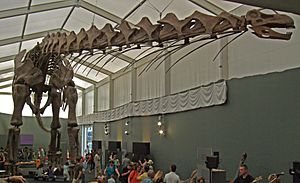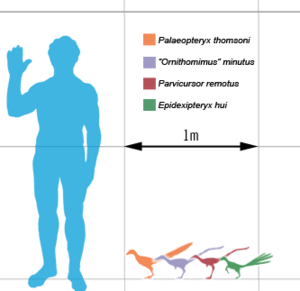Dinosaur size facts for kids
Dinosaurs came in all shapes and sizes! From tiny birds to giant plant-eaters, their size has always fascinated scientists and people everywhere. Some dinosaurs, like the smallest hummingbirds, weighed less than a candy bar. But others, like the huge titanosaurs, could weigh as much as 70 cars!
It's tricky to know for sure which dinosaur was the absolute biggest or smallest. This is because only a tiny number of animals ever turn into fossils. Most fossils stay hidden underground. Even when we find them, we rarely find a complete skeleton. Also, finding skin or other soft parts is very rare.
Scientists try to rebuild dinosaur skeletons by comparing bones to similar animals we know more about. But guessing how much muscle and other organs a living dinosaur had is very hard. This means that guessing a dinosaur's weight is much harder than guessing its length. A cool way to estimate weight is using laser scans to put a "virtual" skin over the skeleton. But even this is still just a guess!
Contents
How Dinosaur Sizes Changed Over Time
Dinosaur sizes changed a lot during the different periods they lived: the Triassic, early Jurassic, late Jurassic, and Cretaceous periods.
Meat-Eating Dinosaurs: The Theropods
Meat-eating dinosaurs, called theropods, were the main predators on land during the Mesozoic Era. Most of them weighed between 100 and 1,000 kilograms (220 to 2,200 pounds). To give you an idea, most large meat-eating mammals today weigh between 10 and 100 kilograms (22 to 220 pounds). So, many theropods were much bigger than today's predators!
Average Dinosaur Size
Most dinosaurs from the Mesozoic Era weighed between one and ten metric tonnes. This is a huge difference compared to mammals that lived after the dinosaurs, during the Cenozoic Era. Scientists at the National Museum of Natural History estimate that the average Cenozoic mammal weighed only about 2 to 5 kilograms (4.4 to 11 pounds). This shows just how massive many dinosaurs were!
Images for kids
-
An adult male bee hummingbird, the smallest known and the smallest living dinosaur
See also
 In Spanish: Anexo:Tamaño de los dinosaurios para niños
In Spanish: Anexo:Tamaño de los dinosaurios para niños








